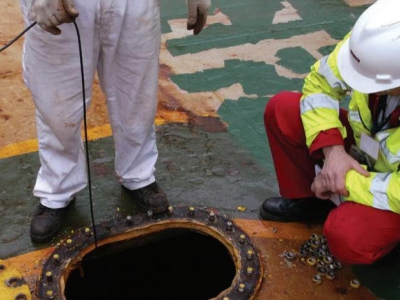SOLAS Regulation III/19 requires drills to be conducted every two months
The Skuld P&I Club has posted on its website an article regarding mandatory drills for entry into enclosed spaces. SOLAS RegulationIII/19 requires enclosed space entry drills as well as rescue drills to be conducted every two months.
Over the years the Association has had to deal with a number of accidents resulting in fatalities which followed the entry in to an enclosed space starved of oxygen or containing harmful gasses, typically due to a failure to follow safety procedures, and this has affected both crew as well as people coming on board such as stevedores.
Incidents have included oxygen starved holds resulting from the carriage of organic cargoes including wheat, timber and logs, but also of mineral cargoes such as DRI or coal. At other times, accidents happened while tanks and / or cargo holds were being inspected or maintenance was carried out.
Tragically, these accidents have at times been compounded, because once it became clear that someone was in trouble, someone else rushed to help them – but without themselves first taking proper precautions and using appropriate safety equipment. On occasion a number of fatalities resulted from such an incident.
The fatality risk
At sea-level, humans require air that contains a certain minimum quantity of oxygen, and that is a requirement for at least 19.5% oxygen. Below that, an environment will be unsafe for human life, basis oxygen % alone.
It must be stressed, however, that even at 19.5% oxygen the air may be unsafe, given that the basic oxygen level of air is 20.9% at sea level.
Where, for instance, the 1.4% difference is taken up by a gas such as carbon monoxide then a person may fall unconscious within a few breaths, and death may follow within 3 minutes.
Hannaford Forensic Services (Asia) Limited, have prepared a note on oxygen level issues.
Regulatory development
Following a deterioration in accidents over time, the IMO developed Regulation III/19 of SOLAS as a way of changing this trend. As of 1 January 2015 mandatory entry and rescue drills will be required every two months. All crew members who have responsibilities for entry in to enclosed spaces, or rescue therefrom, will have to participate in these drills. Further details may be found on IMO Resolution MSC.350(92) .
Guidance with respect to these matters can be found in the recommendations for enclosed space entry from IMO Resolution A.1050(27)
|
Drills shall include the following:
|
It must be stressed that all such drills are meant to be properly planned and carried out with a “safety first” approach. As such no entry in to an enclosed space should be made, other than may be strictly necessary, and while all due safety precautions are fully observed, i.e.: such space should not be opened purely for the drill itself.
The intention of the new regulation is to ensure that all relevant personnel have the necessary awareness of the risks, and are properly trained to follow all the procedures to ensure that any actual enclosed space entry will be done in as safe a manner as possible.
Loss prevention
Given that the risk of an accident is very high, as well as the risk of such accident leading to a fatality, it cannot be stressed enough how serious this issue needs to be taken.
Every crewman should be aware of the risk that an oxygen starved environment presents, and only those crew who have received the necessary training should conduct any entry in to an enclosed space or perform any rescue operation.
Vessels need clear policies that govern the entry in to enclosed spaces and all crew should be advised of the same, with such advice repeat at periodic safety briefings on board.
|
As for either a drill or an actual entry, this needs to cover the following:
|
Source: The Skuld P&I Club
|
Also read relevant SAFETY4SEA articles |
































































